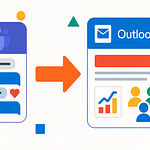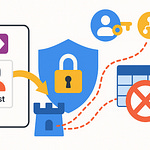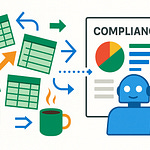Here’s the truth many IT teams don’t realize until after a breach: Microsoft Defender covers more than you think, but much less than you assume. And the costliest mistakes happen in the blind spots you didn’t even know were there. The question isn’t Defender versus Sentinel—the question is whether your current monitoring strategy is quietly failing you right now. In this session, we’ll expose those blind spots and show how to decide if Sentinel is really worth the investment.
The Defender Comfort Zone
Most IT admins assume that turning on Microsoft Defender means they’re fully covered, but the question is—does it actually see everything? That’s where the comfort zone comes in. Defender creates a strong layer of security across Office, Identity, and Endpoint, all sitting neatly inside the Microsoft 365 ecosystem. Out of the box, you get phishing protection in email, behavioral monitoring on endpoints, and identity safeguards through Defender for Identity. It’s designed to work together without much configuration, which is part of the reason so many admins feel safe relying on it. You get alerts on suspicious sign-ins, compromised devices, and malicious files, all flowing into a central console. On the surface, that sounds like full coverage.
Defender is particularly good at connecting signals across Microsoft’s products. If a phishing email slips into Outlook and an employee clicks a malicious link, Defender can trace the chain to what happened next on that user’s endpoint. The user’s device might trigger an alert, showing malware execution, which Defender maps back to the original email. That kind of cross-correlation is a strength because the tools are built by the same vendor and share data by design. It feels like an end-to-end defense system running without extra effort. For day-to-day operations, that’s exactly the kind of visibility admins rely on.
But here’s the catch. Defender’s reach is powerful but time-limited. The standard log and alert retention is often capped at 30 days for some signals and up to 90 days for others. That means if an attacker waits out the clock—remaining inactive for several months before launching the next stage of their attack—you won’t have the logs available to reconstruct what happened before. Try investigating a breach that quietly began four months ago and you’ll hit a wall. The event data you need will already be gone.
Consider a real-world scenario. Imagine a hacker gains access to a privileged account using stolen credentials. Instead of immediately exfiltrating data, they lie low for half a year, occasionally signing in to maintain access, but never triggering a high-severity alert. By the time they finally act, Defender’s data has already rolled off. You can still see the latest actions, but the breadcrumbs that show when and how they first entered are already deleted. Investigators end up piecing together fragments instead of building the full timeline, and in a serious incident, that missing history can mean the difference between containment and continued compromise.
What makes it tougher is that Defender’s strengths—the tight integration and correlation across Microsoft 365—remain confined within that ecosystem. It can connect emails with endpoints, or endpoints with identities, but it won’t link those patterns to an attack on AWS or to logs from your firewall. You get a consistent story, but only inside Microsoft’s garden walls. If your organization’s footprint stretches beyond those services, important signals remain invisible.
A relatable way to think about it is like having home security cameras that automatically delete footage every week. They’re great for catching a package thief today, but if the police come asking for images of a break-in that happened last month, there’s nothing left to show. That’s exactly what many organizations don’t realize about Defender—its protection is immediate but its memory is short.
Now contrast that with what research shows about modern threats. Reports consistently state that the average time to detect a breach is more than 200 days. That’s more than half a year between the initial compromise and someone actually noticing. If your logs only stretch back one or two months, you can’t investigate attacks at the scale or speed adversaries actually operate. This mismatch sets up a worrying blind spot: the very tool you depend on to protect your tenant doesn’t remember old enough data to defend against today’s threat timelines.
This should make you pause. If the average attacker waits quietly for months before causing visible harm, then many organizations might already have compromises sitting just outside Defender’s memory window. That nagging question starts creeping in: if you were breached six months ago, would you even be able to prove it?
So while Defender is incredibly effective as a daily shield—identifying threats, notifying admins, and blocking attacks in progress—it leaves a hidden liability in longer investigations. You don’t notice the gap until you’re already in an incident, and by then, it’s too late to go back. This is where the conversation naturally shifts. Because if Defender is the camera with limited storage, where do you turn for a longer memory and a wider view? That’s where Sentinel starts becoming more than just an optional add-on. It’s the piece designed to capture what Defender forgets.
When 'Good Enough' Fails
Picture this: compliance auditors show up and the first thing they ask for is six months of log history. You open up your Defender console and realize—most of what they’re asking for just isn’t there anymore. Suddenly the question flips from “are we secure” to “can we even prove what happened.” That’s the moment when relying only on Defender starts feeling a lot less comfortable. Because security isn’t just about blocking threats in real time. For regulated industries, it’s about being able to demonstrate what happened months ago, with complete evidence, stored in a way that meets strict requirements.
The reality is that frameworks like GDPR, ISO 27001, and HIPAA aren’t impressed by quick endpoint detections or fancy dashboards. They ask simple, direct questions: how long do you retain data, can you reconstruct an incident from start to finish, and can you prove none of those records were altered. These regulations place clear expectations on organizations to keep logs for extended periods—often six months, a year, or even longer. So while Defender gives you insights for a few weeks or months, that window falls far short of typical compliance needs. And what makes this a real trap is that many administrators only realize this gap when auditors are already in the room asking for proof.
Take one mid-size manufacturing firm as an example. They assumed running Microsoft 365 Defender across identity, endpoint, and email kept them both secure and compliant. The SOC team felt confident until they were asked to provide a one-year log history during an external review. Suddenly, they were scrambling. Defender could only show activity for the last 90 days in some components and only 30 in others. They pulled advanced audit data to fill some pieces, but it still didn’t add up to a complete trail across the whole environment. By the time they realized Defender wasn’t designed to serve as a compliance archive, they were already explaining gaps in front of auditors. That pressure didn’t just come with stress—it came with the possibility of fines if they couldn’t demonstrate proper record keeping.
And here’s what throws people: even if you purchase extra features like advanced auditing in Microsoft 365, you still don’t have a SIEM. Those audit logs can extend retention or expose more detailed activity, but they’re siloed and not designed to weave into a broad security narrative. You can query Microsoft 365 logging, but that still doesn’t provide central correlation, custom analytics, or the long-term storage compliance officers expect. In short, “more logs” doesn’t equal compliance if those logs aren’t structured in a way to meet regulatory standards. They remain lists of events instead of actionable, correlated records.
This is why when you look at adoption patterns, compliance often shows up as an even bigger driver for Sentinel than pure technology needs. Organizations aren’t just adding Sentinel because they want fancier dashboards or smarter queries. They are adding it because without a system to capture and hold that data securely over the long haul, audits and legal obligations become real liabilities. Sentinel’s core design is to ingest, normalize, and retain logs across multiple sources, translating directly into meeting retention policies. It does what Defender, by itself, doesn’t even attempt to do.
Think of it like this. Defender is your front-line shield—it blocks malicious emails on Tuesday morning or quarantines a bad file on a laptop Thursday afternoon. It guards the castle walls in real time. But auditors and regulators want to see the entire war journal—the record of every battle, every alert, every attempt across the year. Their expectation is not to see if you stopped one specific threat, but to prove your monitoring system has an unbroken archive of events that can be referenced months or years later. That’s something only a proper SIEM solution like Sentinel can provide.
And the hidden cost of ignoring this is steep. Regulatory fines for failing retention requirements can exceed any Sentinel subscription fee by orders of magnitude. Worse, reputational damage often follows—clients and partners lose trust when an organization can’t demonstrate accountability. You may save on Azure costs by not extending your capabilities, but a single compliance failure can wipe out budget savings in an instant.
So this is the tipping point. Defender alone is powerful for daily defense, but compliance turns Sentinel from an optional tool into a requirement. If your logs can’t pass the audit test, the argument for adding Sentinel is no longer about features. It’s about survival in a regulated landscape. Which naturally raises the next challenge: how do you extend coverage with Sentinel without creating unnecessary overhead? That’s where things get interesting.
Where Sentinel Shines
If Defender is the fire alarm, Sentinel is the investigator piecing together who set it off and how long they lingered before anyone noticed. The two are very different roles. Defender tells you when something happens right now—it’s about detection and prevention in the moment. Sentinel, on the other hand, is about building the full story, connecting signals that aren’t obvious, and storing the evidence long enough to actually use it in a proper investigation. Without that deeper layer, your security team is always stuck reacting to whatever Defender caught last, instead of answering the harder questions about how incidents started or where they’re spreading.
That’s because Sentinel isn’t just another dashboard—it’s a full cloud-native security information and event management system built around scale. When paired with Defender, you’re suddenly not limited to only Microsoft 365 alerts. You can pull in firewall data, cloud application logs, signals from AWS or GCP, and behavioral feeds from endpoint security tools outside the Microsoft stack. Think of it like extending your monitoring from just your apartment to the entire building. The scope widens, the memory deepens, and the ability to ask custom questions about your environment becomes much more practical.
The hesitation most teams face, though, is cost. Sentinel charges based on the volume of data you ingest and store. Every log and every event adds to the meter. For lean IT operations, that number can look intimidating. But ignoring Sentinel because of sticker shock can cause much bigger costs later. A breach that goes undetected for half a year because signals were siloed doesn’t just mean downtime—it often means compliance penalties, contract losses, and damage to customer trust. For most businesses, that’s the kind of hit that dwarfs the expense of storing data in Sentinel.
Where Sentinel shines is that breadth across platforms and time. It isn’t limited to Microsoft workloads. You can create analytics that connect an odd login attempt on Azure AD with API calls happening inside AWS. Defender would never know those systems relate, but Sentinel stitches it together because it ingests both data sources. Same with long-term retention—you can analyze trends over a year or build baselines of user behavior that only make sense when you look at six months or more of history. Defender’s 30-to-90 day memory doesn’t let you ask those questions. Sentinel does.
There’s a breach story that illustrates this perfectly. An attacker started with a phishing email sent into Microsoft 365. Defender flagged the suspicious message and even quarantined it. But one user clicked before it was pulled. The attacker pivoted, using that identity to log into cloud applications outside Microsoft, eventually exploiting AWS resources. Defender stopped flagging once activity moved off Microsoft infrastructure. For the SOC, the trail ended. But Sentinel had ingested both the Defender alerts and logs coming in from AWS. The correlation took minutes—a compromised user in Microsoft 365 tied directly to unusual API calls in AWS. What looked like two separate issues became a single attack narrative because Sentinel was building bridges across systems.
In practice, it’s not complicated to start. You connect your Defender logs into a Sentinel workspace inside Azure. From there, Defender alerts become just one of the data streams you can query. You create custom rules that automatically elevate certain alerts into full incidents or trigger workflows. Instead of manually chasing down a suspicious login followed by an endpoint malware alert, Sentinel correlates them together into one case, saving analysts precious time. A quick demo of connecting Defender for Endpoint and seeing logs stream into Sentinel usually opens eyes because you instantly see how the data aligns.
The real game-changer is automation. Sentinel integrates with Logic Apps, which means you can design playbooks that run as soon as an alert fires. Imagine a phishing alert automatically disabling the user account, forcing a password reset, notifying the admin, and creating a ticket in ServiceNow—all without human intervention. You set the logic once, and Sentinel enforces it every time. That’s something standalone Defender can’t replicate, because it doesn’t sit in the orchestration layer. Over time, that automation trims response time from hours down to minutes.
And here’s the bonus many don’t realize: Sentinel isn’t just Microsoft-centric. You can plug in Palo Alto firewall logs, SAP audit trails, or even Linux syslogs. Suddenly your central console is more than a Defender extension—it’s a true security operations hub. That reach matters because one of the biggest modern challenges isn’t that Microsoft tools fail, it’s that environments sprawl across multiple vendors. Sentinel breaks down those walls.
So the payoff is simple: Sentinel takes the individual alerts Defender generates and weaves them into a coherent storyline that accelerates detection, investigation, and containment. Instead of chasing unconnected pings, security teams follow a clear narrative grounded in both Microsoft data and everything around it. Which brings us right to the next practical challenge—if Sentinel is this powerful, when do you actually add it to Defender without blowing the budget? That’s where strategy comes in.
Building Smart, Not Expensive
Many teams hesitate to turn on Sentinel because they’re convinced it will send their Azure bill through the roof. On the surface, that fear makes sense—Sentinel charges by the volume of data you ingest and store, and in a world where logs are endless, it sounds like an open tab at a very expensive restaurant. But smart admins know the real picture is different. Sentinel doesn’t need to collect everything, and when configured correctly, it doesn’t double your storage costs. The trick is understanding what data flows in, how it gets ingested, and how to avoid common mistakes that waste money.
The biggest misconception is that flipping on Sentinel instantly means every Defender log is copied over into a new workspace, charging you again for data you already own. That’s where a lot of sticker shock stories come from. Teams assume duplication is inevitable, so the cost estimate skyrockets and the whole project gets shelved. In reality, Defender data can stream directly into Sentinel through data connectors without duplication. You only pay for what Sentinel actually ingests and retains, not for some hidden double-storage fee. So the “I’ll be billed twice” fear is more about misunderstanding the pipeline than the platform itself.
Here’s what this looks like in practice. Defender for Endpoint already produces alerts when devices see suspicious activity. Instead of manually exporting those logs or paying to store them separately, you connect them straight into Sentinel. Now, Sentinel treats those alerts like any other data stream. Because it’s direct ingestion, you’re not running up a second copy of storage—you’re reusing what’s already being produced. That design keeps costs lean, and it also means you can query Defender data inside Sentinel without ever juggling exports or duplicate systems. For admins, that’s one less headache and one less invoice surprise.
But cost management isn’t just about log pipelines. It’s about volume control. Imagine setting Sentinel to ingest every single event without limits—you’d quickly end up with noise drowning out the important stuff. That’s where analytics rules come in. With a simple configuration, you can filter for only the alerts you care about—say, high severity identity risks or unusual admin activity. Sentinel allows you to build rules that immediately promote those alerts into incidents while ignoring lower-tier noise that adds little value. A practical demo would be creating a rule that only ingests Defender alerts tied to suspicious privilege escalation. Now you’ve cut your ingestion sharply while still covering the scenarios that matter most.
Think of your strategy as layered. Defender alone handles the basics: endpoint detections, phishing, identity threats. That covers the day-to-day guard duty. Then you overlay Sentinel selectively for long-term memory and cross-platform correlation. Instead of sending every log line from every endpoint, you stream only critical categories—identity data, endpoints showing advanced alerts, and admin activity streams that auditors care about. You don’t break the bank storing low-level telemetry you’ll never query. The difference is huge. Defender-only monitoring is like looking at today and tomorrow. Sentinel plus selective logs is like having an ongoing archive to go back six months or a year when auditors or investigations come calling.
Scaling Sentinel the smart way means starting with what you already have in Defender XDR. Build your base there. Then, ask yourself which specific logs would be devastating to lose after 90 days. Nine times out of ten, it’s identity and privileged access data. Endpoint alerts follow closely behind. Those are the first candidates for feed-in to Sentinel. Over time, maybe you add specific cloud workloads or firewall logs, but it’s done intentionally, not all at once. That way, each new log stream has a purpose and a cost justification behind it.
Here’s a simple analogy. Treat Sentinel like a security archive vault, not a junk drawer. You don’t dump every receipt, every alert, every piece of paper inside it. You store the critical documents you know you’ll need years later, and you organize them so they’re easy to find. A junk drawer fills up fast and becomes useless. A vault, carefully filled and structured, delivers value at the exact moment you need it. That’s the mindset that keeps Sentinel powerful without making your Azure invoice terrifying.
So the mini outcome here is clear. Sentinel doesn’t have to be expensive. In fact, when connected correctly and trimmed to high-value streams, it enhances your visibility without breaking the budget. The idea isn’t to replace Defender or to treat Sentinel like a dumping ground. It’s to combine the real-time shield you already own with a historical record you actually control. Which brings us to the final piece—figuring out how to map that decision for your own organization so you know where Defender ends and where Sentinel really starts to pay off.
Making the Call for Your Organization
Here’s the real question to ask before signing a Sentinel contract: what risks, if ignored, would actually sink your business? It’s not about whether Sentinel looks good in a demo, or whether your peers are buying it. The real decision comes down to the risks you can live with versus the ones that would cause damage you cannot recover from. Once you frame it that way, the choice between staying with Defender only or layering Sentinel on top becomes less about features and more about survival in your operating environment.
Think of this stage as a decision tree. Defender gives you built-in coverage across Office, Identity, and Endpoint, and it does that well out of the box. Sentinel steps in where retention, cross-cloud integration, and long-term incident analysis matter. The question is: where does Defender stop being enough in your context? Some organizations don’t need more than Defender for daily defense. Others hit compliance walls or visibility gaps within the first quarter. That’s why this isn’t a one-size-fits-all call; it’s about aligning tools with actual needs instead of buying on fear or hype.
Different organizations hit different pain points. A twenty-person consultancy using just Microsoft 365 and a small number of cloud apps has a very different set of risks compared to a multinational handling sensitive health or financial data. Compliance requirements alone can flip the table. If you need to answer to GDPR or HIPAA, the audit trails and retention needs become non-negotiable. If your client contracts require forensic reconstruction of events going back a year, Defender’s standard retention won’t pass a test. But if your environment has little regulatory pressure and endpoints are the main entry point for attackers, then Defender’s built-in XDR capabilities might cover most of what matters.
To make it practical, it helps to walk through three questions. First, how strong is your current security posture—are you confident your configurations are tight, users trained, and existing protections running as intended? Second, what’s your actual threat profile—are you mostly seeing endpoint malware and phishing campaigns, or are you facing cross-cloud or supply chain attacks that span multiple platforms? Third, what retention or compliance requirements are you bound to meet—do your auditors expect a year of logs, or is quick detection the primary goal? Those questions shape the decision faster than any product marketing slide ever could.
Let’s say your biggest problem is still users clicking malicious links. You’ve already rolled out Defender for Office and Defender for Endpoint, and most issues show up there. If that matches your threat profile and you don’t have strict audit needs, then Defender XDR may be enough on its own. On the other hand, if your footprint includes Azure workloads, third-party SaaS, AWS, or a combination of all three, and an attack could thread its way across those environments, then Sentinel becomes less optional. Defender will only tell you part of the story. Sentinel is what ties accounts, cloud resources, and admin activity together into one narrative.
It helps to think in terms of maturity levels. At the foundation, Defender covers the essentials—identity protection, endpoint monitoring, and Office email safeguards. As you climb up into broader oversight, Sentinel becomes the extension that turns these isolated protections into a complete monitoring framework. It graduates your defense from daily blocking into long-term strategy and oversight. That tiering helps explain why some organizations layer Sentinel immediately, while others hold off until scale, compliance, or risk exposure makes it necessary.
Real-world cases make the difference clear. A small marketing agency with thirty employees runs purely on Microsoft 365 and Windows PCs. Their greatest risk is phishing and endpoint compromise. They use Defender across the board, and with proper policies and MFA, it’s worked. They have no large regulatory burden, so the setup fits. Contrast that with a global enterprise handling sensitive client data across Azure, AWS, and on-prem servers. Their SOC discovered that during incidents, piecing logs together was slow and incomplete without Sentinel. For them, Sentinel wasn’t an upgrade— it was essential to even maintain compliance and credibility in client audits.
So it comes down to a single, practical question: am I comfortable with the blind spots I currently live with? If you can answer yes, Defender XDR might be enough. If the thought of not having records for six months, or not spotting cross-cloud connections makes you uneasy, then Sentinel is more than justified. The clarity is this—Defender gives you the daily defense you rely on, while Sentinel ensures you don’t lose the bigger picture over time. That balance sets up the final piece of the puzzle, where we tie these threads into one clear insight you can act on.
Conclusion
Defender is your shield in the moment—it blocks, alerts, and reacts when threats land on your doorstep. But Sentinel is the memory and intelligence that carries forward, preserving history and connecting signals into a story you can use months later. One without the other leaves a gap that attackers quietly exploit.
So here’s the call: don’t wait for an incident to show you what’s missing. Audit your blind spots today, map what you can prove, and test whether your retention stands up. Ask yourself this—if an attack started six months ago in your tenant, could you even prove it?











